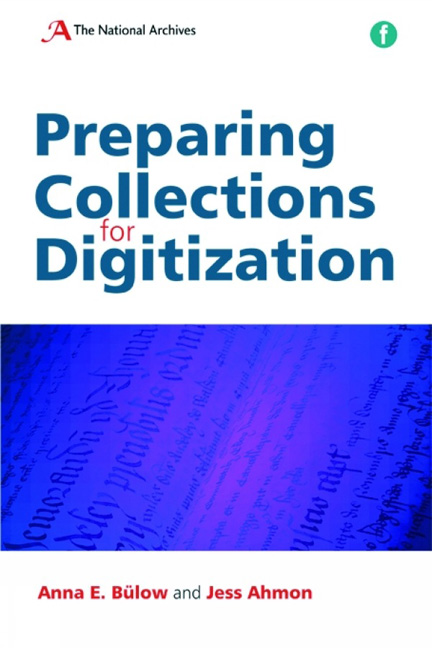Book contents
- Frontmatter
- Contents
- Acknowledgements
- List of figures and tables
- Introduction
- 1 Digitization in the context of collection management
- 2 Before you digitize: resources, suppliers and surrogates
- 3 The digital image Ross Spencer
- 4 The process of selection
- 5 Surveying collections
- 6 Equipment for image capture
- 7 Preparation of document formats and fastenings
- 8 Preparation of damaged documents
- 9 Setting up the imaging operation
- Conclusion
- Further reading
- Index
8 - Preparation of damaged documents
Published online by Cambridge University Press: 08 June 2018
- Frontmatter
- Contents
- Acknowledgements
- List of figures and tables
- Introduction
- 1 Digitization in the context of collection management
- 2 Before you digitize: resources, suppliers and surrogates
- 3 The digital image Ross Spencer
- 4 The process of selection
- 5 Surveying collections
- 6 Equipment for image capture
- 7 Preparation of document formats and fastenings
- 8 Preparation of damaged documents
- 9 Setting up the imaging operation
- Conclusion
- Further reading
- Index
Summary
Introduction
Preparing a collection for imaging as described in Chapter 7 ‘Preparation of document formats and fastenings’ will help to ensure effective and efficient image capture. However, if items in a collection are damaged then this will also need to be addressed. Preparing damaged documents for image capture need not be a lengthy and expensive process. However, it will undoubtedly add to the costs of a project because, although it is not full conservation treatment, it should nevertheless be carried out by a qualified conservator. This makes it all the more important that the collection survey quantifies the amount of work needed so that an estimate of costs can be incorporated into the project budget at an early stage (see Chapter 5 ‘Surveying collections’). It is then possible to make informed decisions about whether or not a project conservator is needed and how conservation work might fit in with the imaging operation. This may need careful consideration because the nature of the preparation that is required may have an impact on the overall logistics.
Is conservation work always needed?
The short answer to this question is ‘no’ because the spot check and survey may suggest that there are no damaged items. In fact this may be one of the reasons why a particular collection was selected for digitization. However, if a proportion of the collection is found to be in fragile condition then these items can simply be excluded from the image capture, as discussed in Chapter 5 ‘Surveying collections’. If a full collection survey has been carried out then this will indicate which items should be excluded. If a sampled survey was carried out then an assessment stage to weed out unfit items may be needed during the imaging operation. However, if the imaging team are having to repeatedly reject items because they are unfit this is not a good use of their time and also unnecessarily uses resources for document ordering, tracking and delivery only to result in items being returned without being imaged. A full survey is therefore prefereable so that every item has been assessed in advance of the imaging.
- Type
- Chapter
- Information
- Preparing Collections for Digitization , pp. 137 - 158Publisher: FacetPrint publication year: 2010



